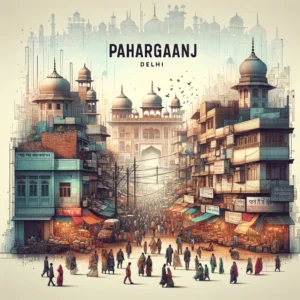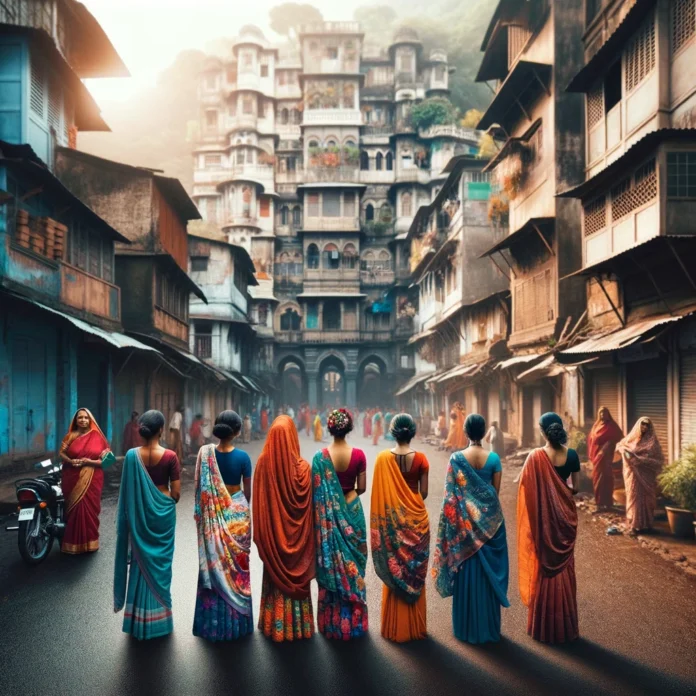The Debate on Legalizing Prostitution Red Light in India
Prostitution in India is a topic that’s complicated and sensitive. Even though it’s legal to be a sex worker, the rules around it are tricky. For example, you can’t openly ask for clients in public places or run a brothel. Discussions about whether or not prostitution should be fully legal aren’t very clear or open, which makes it hard to improve the situation. Despite these challenges, India has one of the biggest markets for sex work in the world.
Many famous red-light districts in India are known globally, and some people even make videos (vlogs) exploring these areas. One of the most talked-about places is Sonagachi in Kolkata, which is the largest red-light district in Asia. Below, I’ll talk about some notable red-light areas across India and what makes each unique:

1. Kamathipura, Mumbai: This place is one of the oldest areas where sex work happens in India. It’s in the heart of Mumbai and has thousands of sex workers. Despite its reputation, it’s a place where many people work to make a living under tough conditions.
2.Foras Road, Mumbai: This area is known for entertainment and dance performances, showing how diverse the sex industry can be. Over time, it has changed and now includes more modern forms of entertainment.

3. Turbhe Tekdi, Mumbai: This area became popular because it was cheaper and accessible for many sex workers, especially when other areas became too expensive or were closed down. It shows how people in this industry often have to move or adapt to new situations.
4. Budhwar Peth, Pune: This is one of the biggest red-light districts in India and has made efforts to be safer for sex workers, like requiring the use of condoms. It’s an example of how people are trying to make the best out of difficult circumstances.

5. Meerganj, Allahabad: Known for being risky due to illegal activities, this area highlights the dangers and challenges faced by sex workers, showing the need for better protection and support.
6. Garstin Bastion Road in Delhi: The area is full of hostels and the extent of sex trafficking is clearly visible. It’s like his world is in the city.

7.Paharganj, Delhi: This place is interesting because it combines with other businesses such as hotels and bars and shows how sex trafficking hides in plain sight.
8. Chaturbhujsthan, Muzaffarpur: This area is steeped in history and a reminder of how deep-rooted sex work is in some sections of Indian society and co-exists with other aspects of life.

9. Sonagachi, Kolkata: Asia’s largest red light district, Sonagachi is a symbol of the scale and complexity of the sex trade in India, a society that faces many challenges but also shows patience.

10. Kalighat, Kolkata: This place is unique as it is both a place of religion and a beacon that shows the difference between different people in the region.
These red-light areas each have their own stories, reflecting broader issues in society. They show us that people in the sex industry face a lot of challenges and that understanding their lives requires empathy and willingness to learn beyond stereotypes.
In India, the laws about sex work are pretty complicated. There’s a law from 1956 called The Immoral Traffic (Suppression) Act, or SITA, which says that sex workers are allowed to do their work in private but can’t legally look for clients in public places. Even though there are some news reports saying that all prostitution is illegal in India, the law doesn’t actually say that selling your own sexual services is called “prostitution.” But there are clear rules against things related to sex work, like running a brothel or trying to get clients near a public place.

Now, while SITA was supposed to manage these issues, it’s not used much. Instead, the Indian Penal Code, a much older law, is often applied to charge sex workers with crimes like “public indecency” without really defining what that means. In 1986, SITA was updated to the Immoral Traffic (Prevention) Act, or ITPA, which tried to set clearer rules. Even though there have been suggestions to change this law to punish clients of sex workers, these have faced a lot of opposition, especially from health officials.
what the ITPA says
Sex Workers: If a sex worker tries to attract clients in public, especially near certain public areas, they can be prosecuted.
Clients: If a client is caught with a sex worker within 200 yards of a public place, they can be in trouble, especially if the sex worker is under 18.
Pimps: People who make money off a sex worker’s earnings, like pimps or partners, are doing something illegal.
Brothel Keeping: Running or owning a place where sex work happens is not allowed.
Human Trafficking: It’s a crime to try to recruit someone into sex work or move them for this purpose.
There’s also something positive: the law says the government must help sex workers who ask for it, providing them with things like a safe place to live.
Different groups have been arguing about these laws for years. Some say the laws should change to make life safer for sex workers and to stop human trafficking. The Supreme Court of India has even talked about making prostitution legal to help protect sex workers better. They want to make sure that sex workers can do their job safely and with dignity, just like everyone deserves.
In 2022, the Supreme Court agreed that sex workers should have the same rights as everyone else, including the right to a decent life, meaning they should not be harassed or arrested for doing their job. However, things related to running a business are still illegal.
The debate continues as some want to change the law to help sex workers, while others worry about the impact the change will have on society. how
Many sex workers in India do not work because they want to, but because they want to make a living or Because they don’t have many ways to support their families. Sometimes, when the marriage ends or is not welcomed by the family, people have no other choice and turn to sex work to survive. Children of sex workers are also more likely to enter the trade themselves.
Research by an organization called Sanlaap shows that most sex workers didn’t enter the field by choice. They conducted a survey in Kolkata and found that out of 160 sex workers, only 23 said they joined willingly. The rest were brought into the profession through various means, often involving people they knew:
– 7 were influenced by neighbors in agreement with their parents.
– 19 were tricked by neighbors acting as pimps without their guardians knowing.
– 31 were introduced by older sex workers from their area.
– 32 met someone randomly who turned out to be a pimp.
– 18 had family members already in the profession who brought them in.
– Some were deceived by partners promising marriage or jobs, then selling them to brothels.
Interestingly, the majority of those who brought them into sex work were not strangers but people they knew, like neighbors or relatives.
In some regions, like parts of Bengal, there’s a system called Chukri, where women are forced into sex work to clear a debt, and they work for long periods without pay. The Indian government has tried to help people escape forced labor, including sex work, with programs that offer support and financial aid.
There are also communities in India where prostitution is seen as a family tradition. For example, in the Banchhada (or Banchada) tribe, it’s expected that the eldest daughter will become a sex worker to support her relatives.
Many women and girls from Nepal end up as sex workers in India too. In the 1990s, it’s estimated that up to 200,000 Nepalese girls, some very young, were sold into the sex trade in India.
Indian arts and literature have often referred to prostitution, showing its presence in society through the ages. A classical example comes in the form of the ancient play “Mrichakatika,” drafted about two millennia back and which orbits around the life of a celebrated courtesan called Vasantsena. This tale was so influential that it was adapted into a Hindi movie, “Utsav,” in 1984.
Another poignant tale is that of Amrapali, an enormously famous courtesan of the ancient Kingdom of Vaishali, who later donned the robe of enlightenment and took up the life of a Buddhist nun. A very beautiful Bollywood movie based on her engrossing story, “Amrapali,” came on the silver screen in the year 1966.
The 2004 American documentary “Born into Brothels,” much later, threw light on the lives of children born to prostitutes in Sonagachi, Kolkata. It won global attention for their misery and bagged an Academy Award.
Further, the documentary “Tales of the Night Fairies”Shohini Ghosh is Sajjad Zaheer Professor at the AJK Mass Communication Research Centre at Jamia Millia Islamia (Central University) in New Delhi. From 1990 to 1996, she was Visiting Associate Professor of the Department of Communication at Cornell University in Ithaca, New York, and Globalization-McArthur Fellow at the University of Chicago in 2001.
She has also served as Fellow at the Gender, Sexuality and Law Research Group of the Law Department at Keele University in the United Kingdom, and Visiting Professor at the Summer Institute on Sexuality, Culture and Society at the University of Amsterdam. Ghosh writes extensively on popular culture and the media for both academic journals and the popular press. A major part of her current work involves theoretical interventions in public debates around issues of sexuality, speech and censorship
by Delhi filmmaker Shohini Ghosh in 2002, brings out in the open the lives of five sex workers in Kolkata who are fighting not only for survival but are part of DMSC – the sex-worker union, fighting for rights: struggle against human trafficking.
Is it safe for visitors to go to red-light areas? Not at all they should not be encouraged to go to red-light areas. The various other types of criminal activities are known from such places, and visitors may expose themselves to risk. Besides, such activities are illegal and may invite severe repercussions.
What can be done to address the issues related to prostitution ?
The problems of prostitution need to be taken up with sensitivity. The government, NGOs, and society need to offer help and services to sex workers in the range of health, education, and vocational training. There is also a need to scale up efforts to prevent human trafficking through providing alternative sources of livelihood and advocating for their rights and dignity, among others, through awareness creation.

Understanding the multifaceted world of sex work in India: A closer look
India’s approach to sex work is layered and deep, combining legal process with deep conversations. Although sex work itself is not illegal, many activities surround it, creating a contradictory situation that affects life in the industry.
Legal Status
Imagine a world where your work is in a legal gray area. This is the reality faced by many sex workers in India, where the law does not restrict their work but increases the risk of criminal activity. This not only makes their work dangerous but also limits their ability to seek help and protection. For these reasons, legal reforms focusing on the safety and rights of sex workers are essential. This is to ensure that they are protected and respected in the same way as workers in other sectors and are not subject to abuse or exploitation.
Business implications
Now let’s think about why someone would get into the sex business. Often this is not a choice but a way of survival resulting from factors such as poverty, lack of education or limited employment. To solve the problem of sexism, we need to address these principles and provide people with opportunities through education and work.
This approach not only helps those at risk of entering the sex trade, but also provides a path for those who want to exit the sex trade.
Cultural Context and Stigma
Gender roles are stigmatized in many societies, including India, resulting in the image of employees and their families being overshadowed.
This stigma can lead to isolation, mental health problems, and ongoing poverty. By changing the way we think and seeing gender workers as human beings with rights and dignity, we can begin to break this stigma and create a more compassionate and understanding society.
Health and safety issues
Health is a major issue in the sex trade and there is also a risk of sexual assault and violence. Protecting the health of sex workers is not only about their health
This is a public health problem. Ensuring access to healthcare, safe sex products and information is critical. Moreover, protecting them from violence and crime is not only justice but also human dignity.
The Power of Advocacy
When sex workers come together and make their voices heard, they can make a big difference. Advocacy groups led by gender workers have proven effective in advancing their rights, health and dignity. Supporting these groups and listening to the experiences and needs of sex workers can lead us to create effective and humane policies.
See next section
“Support, Acceptance, Change”
Addressing the complexities of sex work in India will not be easy by simply changing rules or regulations; it’s about changing attitudes, offering support and accepting that everyone is human. By adopting a more negative and thoughtful approach, we can move towards a future where gender workers are not stigmatized or stigmatized, are respected members of society, and can enjoy their rights and opportunities.




